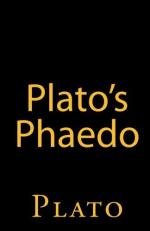|
This section contains 536 words (approx. 2 pages at 400 words per page) |

|
Plato's Phaedo Summary & Study Guide Description
Plato's Phaedo Summary & Study Guide includes comprehensive information and analysis to help you understand the book. This study guide contains the following sections:
This detailed literature summary also contains Topics for Discussion and a Free Quiz on Plato's Phaedo by Plato.
The Phaedo is one of the great works of philosophy, written by the ancient Greek philosopher Plato about the last days of his teacher, the historical figure Socrates. The Phaedo is a Socratic dialogue, which is a particular sub-genre of philosophical literature in which Plato uses Socrates's discussions with various citizens of Athens to inquire into various philosophical issues. The Socratic dialogues are among the first known works of philosophy and more or less inaugurated the entire practice of philosophy that continues to this day.
Little is known about Socrates. He is thought to have lived between 469 and 399 B.C. He was an Athenian citizen who spent his days wandering Athens and questioning its important citizens on philosophical issues. All of what is known about Socrates is second-hand and most of it is disputed, but his famous trial and death, caused by the accusation of the Athenians that his philosophical practices corrupted the youth, is perhaps the "creation story" of philosophy.
Socrates lived the paradigmatic philosophical life and in legend is thought to have cared for nothing but discovering the philosophical truth. He had many followers, some of whom went on to be some of history's great philosophers. The difficulty with the history of Socrates, however, is that Plato and those others who wrote about him sometimes used his character to elaborate on their own philosophy.
Some Socratic dialogues are thought to be more or less accurate representations of real discussions, but others clearly are not. In the Phaedo, for instance, Plato sends an explicit message through his character Phaedo that he, Plato, was not present for the events which took place. Thus, the dialogue is more clearly one of those used to express its author's point of view. In fact, this is reasonably clear given that the Phaedo is one of the quintessential expressions of Plato's philosophy.
Plato (429-347 B.C.) was perhaps Socrates's greatest student. He is one of Western civilization's great writers and is perhaps the most influential author in philosophical history. He was an Athenian citizen of high status and raises some of the most profound philosophical questions of anyone. Plato's philosophy is characterized by several distinct doctrines, many of which come through in the Phaedo; the Phaedo is more or less one of Plato's philosophical manifestos.
The Phaedo itself takes place after the arrest and trial of Socrates. Socrates is in prison and has been sentenced to death. He has already refused to escape in the Socratic dialogue, the Crito, and is waiting to drink poison. In a last visit with his friends and followers, he discusses with them the nature of the soul and whether it can survive death. Socrates gives an extended argument that the soul is immortal and is improved when it leaves the body. He then outlines his understanding of the structure of the world and the afterlife. At the end of the dialogue, Socrates drinks the poison and dies.
The dialogue as a whole takes place as a conversation between Phaedo, one of Socrates's followers, and Echecrates, another of his followers that was not present. However, Phaedo relates the events as primarily a conversation between Socrates and his followers Cebes and Simmias.
Read more from the Study Guide
|
This section contains 536 words (approx. 2 pages at 400 words per page) |

|



